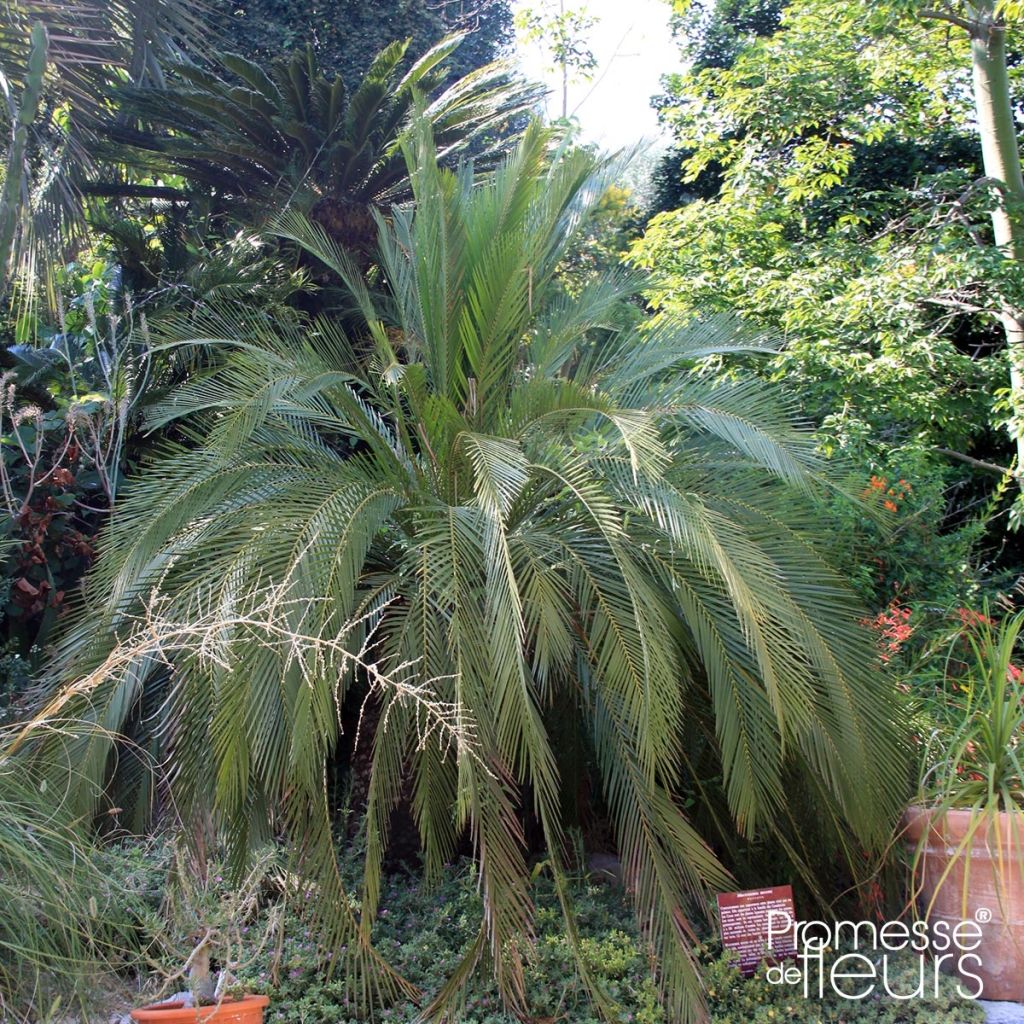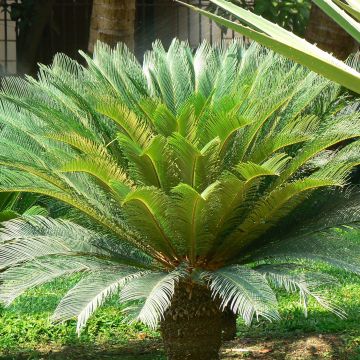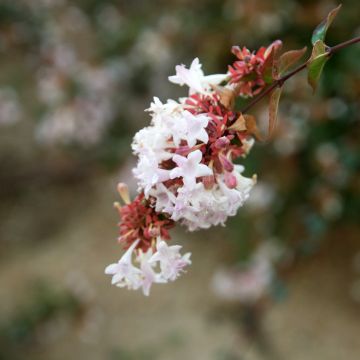

Macrozamia moorei - Cycas de Moore


Macrozamia moorei - Cycas de Moore
Macrozamia moorei
Macrozamia moorei
Moore's Cycad
This plant carries a 24 months recovery warranty
More information
We guarantee the quality of our plants for a full growing cycle, and will replace at our expense any plant that fails to recover under normal climatic and planting conditions.
From €5.90 for pickup delivery and €6.90 for home delivery
Express home delivery from €8.90.
Does this plant fit my garden?
Set up your Plantfit profile →
Description
Macrozamia moorei is a very beautiful exotic plant that is sometimes called Moore's Cycas, as it is related to Cycas. Although not very hardy, it is sought after by collectors for its stout palm-like appearance and its lush fountain-like foliage. This species forms a stout and rough trunk after many years, bearing a beautiful crown of long, slightly arched leaves that are intensely divided into very fine and prickly leaflets of a blue-green colour. It can only be grown in the ground in regions where temperatures rarely fall below -5°C (23 °F). It should be planted in a well-draining soil, dry in winter, with the crown is protected with winter covering. This large Macrozamia can also thrive in a large pot, but should be stored indoors during colder regions.
Macrozamia moorei belongs to the family Zamiaceae, which includes about 238 species native to tropical and warm temperate regions of Africa, Australia, and South America. It is a very ancient botanical family, showing primitive characteristics. This species is native to central Queensland in Australia, where it is found in rather arid areas, on rocky and poor terrain. Its can withstand the cold as low as -6°C (21.2 °F) for mature subjects: but the foliage can be scorched at -3°C (26.6 °F). The stump is likely to regenerate in spring if it has received good winter protection. Macrozamia is a dioecious plant, meaning that there are separate male and female plants. All parts of the plant are toxic if eaten.
In cultivation, this plant will rarely exceed 3.50m (11 ft 6 in) in all directions, even less if the plant is grown in a pot. Its growth is slow to very slow depending on the growing conditions. Anchored on a partially underground caudex with the upper part visible above the ground, the common Macrozamia develops a short and thick stipe over time, a sort of brownish false trunk with a rough texture, showing leaf scars. The interior of the trunk is composed of spongy tissue rich in starch. At the top, the foliage develops, assembled into a large spherical crown. The foliage is evergreen throughout the year. The intensely pinnate leaves, initially supple and then trailing, measuring 1.50m (4 ft 11 in) to 2m (6 ft 7 in) in length, are divided into 100 to 250 carinate, leathery, and glossy leaflets. They are carried by a spiny petiole. The roots of Macrozamia moorei associate with numerous soil microorganisms, fungi, and bacteria, in order to tolerate the difficult soils that are suitable for it, both poor and dry.
Flowering occurs in summer, after many years of cultivation (10 to 15 years), and is rather rare in our climates. The inflorescences appear in the center of the crown. They take the form of green-brown cylindrical cones, resembling pineapples. The female cones release large winged seeds when ripe, of a light and vivid red colour.
Macrozamia moorei prefers partial shade and requires a well-draining soil, that is dry in winter. It is better adapted to the Mediterranean coast and can withstand drought once established. In the ground, it can be placed in an exotic-inspired setting, not far from a swimming pool for example, along with a small palm tree, dwarf banana trees, or small bamboos. However, this plant will reach its potential as a specimen. Plant it in a contemporary garden over a tide of white pebbles. It will make a magnificent specimen in a conservatory, in a temperate greenhouse, on the patio, or balcony or planted in a carefully chosen large container.
Report an error about the product description
Macrozamia moorei in pictures




Plant habit
Flowering
Foliage
Botanical data
Macrozamia
moorei
Zamiaceae
Moore's Cycad
Australia
Other Cycas
Planting and care
Plant the Macrozamia purchased in a container in spring, in open ground, on the southern Atlantic or Mediterranean coast. Acclimatization trials in zone 9b seem conclusive, provided good winter protection against cold and humidity. Choose a semi-shaded location (avoid scorching sun, especially in the South) and sheltered from prevailing winds. Plant it in a very well-drained, sandy or rocky soil, low in organic matter, rather dry in winter. Wrap the crown in a thick winter veil and protect the stump from rain. Once established, the plant tolerates water shortage in summer (in open ground).
Elsewhere in France, cultivate Moore's macrozamia in a large pot, which you will take out on the terrace or in the garden in May. It will adapt well to cultivation in a temperate greenhouse or in a cool conservatory in winter, with an atmosphere that is not too dry. Avoid direct sunlight.
Add a good layer of gravel, clay balls or small stones to the bottom of the pot or planting hole, which ideally should be 2 to 3 times the size of the root ball. Then make a mixture of 1/3 fine garden soil, 1/3 compost and 1/3 sand. Water regularly in summer, allowing the substrate to dry between waterings. Avoid fertilizers that may disrupt the soil's symbiosis with the roots: it is preferable to replace the top layer of the planting substrate with fresh compost every spring. Reduce watering in winter. Regularly remove dried leaves at the base of the trunk. Occasionally spray the foliage, especially if the atmosphere is dry.
In a greenhouse or indoors, Macrozamia may be attacked by mealybugs and red spiders, indicating a too dry and poorly ventilated atmosphere.
Note:
Macrozamia is particularly toxic to herbivores and humans. Keep young children and pets away from its beautiful leaves, strange flowers, or tempting fruits!
Planting period
Intended location
Care
This item has not been reviewed yet - be the first to leave a review about it.
Evergreen shrubs
Haven't found what you were looking for?
Hardiness is the lowest winter temperature a plant can endure without suffering serious damage or even dying. However, hardiness is affected by location (a sheltered area, such as a patio), protection (winter cover) and soil type (hardiness is improved by well-drained soil).

Photo Sharing Terms & Conditions
In order to encourage gardeners to interact and share their experiences, Promesse de fleurs offers various media enabling content to be uploaded onto its Site - in particular via the ‘Photo sharing’ module.
The User agrees to refrain from:
- Posting any content that is illegal, prejudicial, insulting, racist, inciteful to hatred, revisionist, contrary to public decency, that infringes on privacy or on the privacy rights of third parties, in particular the publicity rights of persons and goods, intellectual property rights, or the right to privacy.
- Submitting content on behalf of a third party;
- Impersonate the identity of a third party and/or publish any personal information about a third party;
In general, the User undertakes to refrain from any unethical behaviour.
All Content (in particular text, comments, files, images, photos, videos, creative works, etc.), which may be subject to property or intellectual property rights, image or other private rights, shall remain the property of the User, subject to the limited rights granted by the terms of the licence granted by Promesse de fleurs as stated below. Users are at liberty to publish or not to publish such Content on the Site, notably via the ‘Photo Sharing’ facility, and accept that this Content shall be made public and freely accessible, notably on the Internet.
Users further acknowledge, undertake to have ,and guarantee that they hold all necessary rights and permissions to publish such material on the Site, in particular with regard to the legislation in force pertaining to any privacy, property, intellectual property, image, or contractual rights, or rights of any other nature. By publishing such Content on the Site, Users acknowledge accepting full liability as publishers of the Content within the meaning of the law, and grant Promesse de fleurs, free of charge, an inclusive, worldwide licence for the said Content for the entire duration of its publication, including all reproduction, representation, up/downloading, displaying, performing, transmission, and storage rights.
Users also grant permission for their name to be linked to the Content and accept that this link may not always be made available.
By engaging in posting material, Users consent to their Content becoming automatically accessible on the Internet, in particular on other sites and/or blogs and/or web pages of the Promesse de fleurs site, including in particular social pages and the Promesse de fleurs catalogue.
Users may secure the removal of entrusted content free of charge by issuing a simple request via our contact form.
The flowering period indicated on our website applies to countries and regions located in USDA zone 8 (France, the United Kingdom, Ireland, the Netherlands, etc.)
It will vary according to where you live:
- In zones 9 to 10 (Italy, Spain, Greece, etc.), flowering will occur about 2 to 4 weeks earlier.
- In zones 6 to 7 (Germany, Poland, Slovenia, and lower mountainous regions), flowering will be delayed by 2 to 3 weeks.
- In zone 5 (Central Europe, Scandinavia), blooming will be delayed by 3 to 5 weeks.
In temperate climates, pruning of spring-flowering shrubs (forsythia, spireas, etc.) should be done just after flowering.
Pruning of summer-flowering shrubs (Indian Lilac, Perovskia, etc.) can be done in winter or spring.
In cold regions as well as with frost-sensitive plants, avoid pruning too early when severe frosts may still occur.
The planting period indicated on our website applies to countries and regions located in USDA zone 8 (France, United Kingdom, Ireland, Netherlands).
It will vary according to where you live:
- In Mediterranean zones (Marseille, Madrid, Milan, etc.), autumn and winter are the best planting periods.
- In continental zones (Strasbourg, Munich, Vienna, etc.), delay planting by 2 to 3 weeks in spring and bring it forward by 2 to 4 weeks in autumn.
- In mountainous regions (the Alps, Pyrenees, Carpathians, etc.), it is best to plant in late spring (May-June) or late summer (August-September).
The harvesting period indicated on our website applies to countries and regions in USDA zone 8 (France, England, Ireland, the Netherlands).
In colder areas (Scandinavia, Poland, Austria...) fruit and vegetable harvests are likely to be delayed by 3-4 weeks.
In warmer areas (Italy, Spain, Greece, etc.), harvesting will probably take place earlier, depending on weather conditions.
The sowing periods indicated on our website apply to countries and regions within USDA Zone 8 (France, UK, Ireland, Netherlands).
In colder areas (Scandinavia, Poland, Austria...), delay any outdoor sowing by 3-4 weeks, or sow under glass.
In warmer climes (Italy, Spain, Greece, etc.), bring outdoor sowing forward by a few weeks.














































